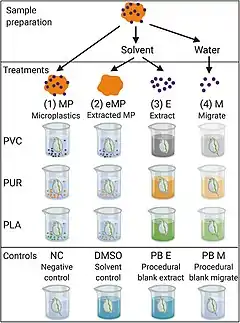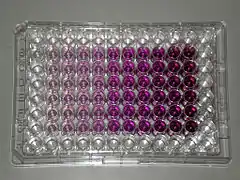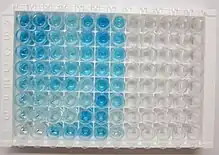Bioassay
A bioassay is an analytical method to determine the concentration or potency of a substance by its effect on living animals or plants (in vivo), or on living cells or tissues(in vitro).[1][2] A bioassay can be either quantal or quantitative, direct or indirect.[3] If the measured response is binary, the assay is quantal, if not, it is quantitative.[3]


A bioassay may be used to detect biological hazards or to give an assessment of the quality of a mixture.[4] A bioassay is often used to monitor water quality as well as wastewater discharges and its impact on the surroundings.[5] It is also used to assess the environmental impact and safety of new technologies and facilities.
Principle
A bioassay is a biochemical test to estimate the potency of a sample compound. Usually this potency can only be measured relative to a standard compound.[3][1] A typical bioassay involves a stimulus (ex. drugs) applied to a subject (ex. animals, tissues, plants). The corresponding response (ex. death) of the subject is thereby triggered and measured.[6]
History
The first use of a bioassay dates back to as early as the late 19th century, when the foundation of bioassays was laid down by German physician Paul Ehrlich.[7] He introduced the concept of standardization by the reactions of living matter.[7][6] His bioassay on diphtheria antitoxin was the first bioassay to receive recognition.[8] His use of bioassay was able to discover that administration of gradually increasing dose of diphtheria in animals stimulated production of antiserum.[9]
One well known example of a bioassay is the "canary in the coal mine" experiment.[10] To provide advance warning of dangerous levels of methane in the air, miners would take methane-sensitive canaries into coal mines. If the canary died due to a build-up of methane, the miners would leave the area as quickly as possible.
Many early examples of bioassays used animals to test the carcinogenicity of chemicals.[11] In 1915, Yamaigiwa Katsusaburo and Koichi Ichikawa tested the carcinogenicity of coal tar using the inner surface of rabbit's ears.[11]
From the 1940s to the 1960s, animal bioassays were primarily used to test the toxicity and safety of drugs, food additives, and pesticides.[11]
Beginning in the late 1960s and 1970s, reliance on bioassays increased as public concern for occupational and environmental hazards increased.[11]
Classifications
Direct assay
In a direct assay, the stimulus applied to the subject is specific and directly measurable, and the response to that stimulus is recorded. The variable of interest is the specific stimulus required to produce a response of interest (ex. death of the subject).[6][12]
Examples
ELISA (Enzyme-linked immunosorbent assay)

ELISA is a quantitative analytical method that measures absorbance of color change from antigen-antibody reaction (ex. Direct, indirect, sandwich, competitive).[13] ELISA is used to measure a variety of substances in the human body, from cortisol levels for stress to glucose level for diabetes.
Home pregnancy test
Home pregnancy tests use ELISA to detect the increase of human chorionic gonadotropin (hCG) during pregnancy.[14]
HIV test
HIV tests also use indirect ELISA to detect HIV antibodies caused by infection.[14]
Environmental bioassays
Environmental bioassays are generally a broad-range survey of toxicity. A toxicity identification evaluation is conducted to determine what the relevant toxicants are. Although bioassays are beneficial in determining the biological activity within an organism, they can often be time-consuming and laborious. Organism-specific factors may result in data that are not applicable to others in that species. For these reasons, other biological techniques are often employed, including radioimmunoassays. See bioindicator.
Water pollution control requirements in the United States require some industrial dischargers and municipal sewage treatment plants to conduct bioassays. These procedures, called whole effluent toxicity tests, include acute toxicity tests as well as chronic test methods.[5] The methods involve exposing living aquatic organisms to samples of wastewater for a specific length of time.[15][16] Another example is the bioassay ECOTOX, which uses the microalgae Euglena gracilis to test the toxicity of water samples.[17] (See Bioindicator#Microalgae as bioindicators and water quality)
See also
References
- Hoskins, W. M.; Craig, R. (1962-01-01). "Uses of Bioassay in Entomology". Annual Review of Entomology. 7 (1): 437–464. doi:10.1146/annurev.en.07.010162.002253. ISSN 0066-4170. PMID 14449182.
- "Guidance for Industry: Potency Tests for Cellular and Gene Therapy Products". Washington, D.C.: U.S. Food and Drug Administration. January 2011. p. 7.
- Laska, E M; Meisner, M J (1987-04-01). "Statistical Methods and Applications of Bioassay". Annual Review of Pharmacology and Toxicology. 27 (1): 385–397. doi:10.1146/annurev.pa.27.040187.002125. ISSN 0362-1642. PMID 3579242.
- Prinsloo, Gerhard; Papadi, Georgia; Hiben, Mebrahtom G.; Haan, Laura de; Louisse, Jochem; Beekmann, Karsten; Vervoort, Jacques; Rietjens, Ivonne M.C.M. (2017). "In vitro bioassays to evaluate beneficial and adverse health effects of botanicals: promises and pitfalls". Drug Discovery Today. 22 (8): 1187–1200. doi:10.1016/j.drudis.2017.05.002. PMID 28533190.
- "Permit Limits-Whole Effluent Toxicity (WET)". National Pollutant Discharge Elimination System (NPDES). Washington, D.C.: U.S. Environmental Protection Agency (EPA). 2021-10-11.
- Saha, G. M (29 November 2002). Design and Analysis for Bioassays. Kolkata: Indian Statistical Institute. pp. 61–76.
- Van Noordwijk, Jacobus (1989). "Bioassays in whole animals". Journal of Pharmaceutical and Biomedical Analysis. 7 (2): 139–145. doi:10.1016/0731-7085(89)80077-9. PMID 2488614.
- Analysis of foods and beverages : modern techniques. Charalambous, George, 1922-1994. Orlando: Academic Press. 1984. ISBN 0121691608. OCLC 9682930.
{{cite book}}: CS1 maint: others (link) - Bosch, Fèlix; Rosich, Laia (2008). "The Contributions of Paul Ehrlich to Pharmacology: A Tribute on the Occasion of the Centenary of His Nobel Prize". Pharmacology. 82 (3): 171–179. doi:10.1159/000149583. ISSN 0031-7012. PMC 2790789. PMID 18679046.
- "Environmental Inquiry - How Are Bioassays Used in the Real World?". ei.cornell.edu. Retrieved 2017-12-01.
- Beyer, L. A .; Beck, B. D.; Lewandowski, T. A. (2011-04-01). "Historical perspective on the use of animal bioassays to predict carcinogenicity: Evolution in design and recognition of utility". Critical Reviews in Toxicology. 41 (4): 321–338. doi:10.3109/10408444.2010.541222. ISSN 1040-8444. PMID 21438739. S2CID 2269998.
- Le, Chap. "Direct Bioassays & Estimation of Ratios" (PDF). Retrieved 15 June 2021.
- Aydin, Suleyman (2015). "A short history, principles, and types of ELISA, and our laboratory experience with peptide/protein analyses using ELISA". Peptides. 72: 4–15. doi:10.1016/j.peptides.2015.04.012. PMID 25908411. S2CID 36486495.
- Manz, Andreas; Dittrich, Petra S.; Pamme, Nicole; Iossifidis, Dimitri (2015). Bioanalytical chemistry. Manz, A. (Andreas), Dittrich, Petra S., 1974-, Pamme, Nicole., Iossifidis, Dimitri. (Second ed.). London. ISBN 9781783266715. OCLC 897825792.
- Methods for Measuring the Acute Toxicity of Effluents and Receiving Waters to Freshwater and Marine Organisms (Report). EPA. October 2002. EPA-821-R-02-012.
- "Whole Effluent Toxicity Methods". Clean Water Act Analytical Methods. EPA. 2020-08-01.
- Tahedl, Harald; Hader, Donat-Peter (1999). "Fast examination of water quality using the automatic biotest ECOTOX based on the movement behavior of a freshwater flagellate". Water Research. 33 (2): 426–432. doi:10.1016/s0043-1354(98)00224-3.